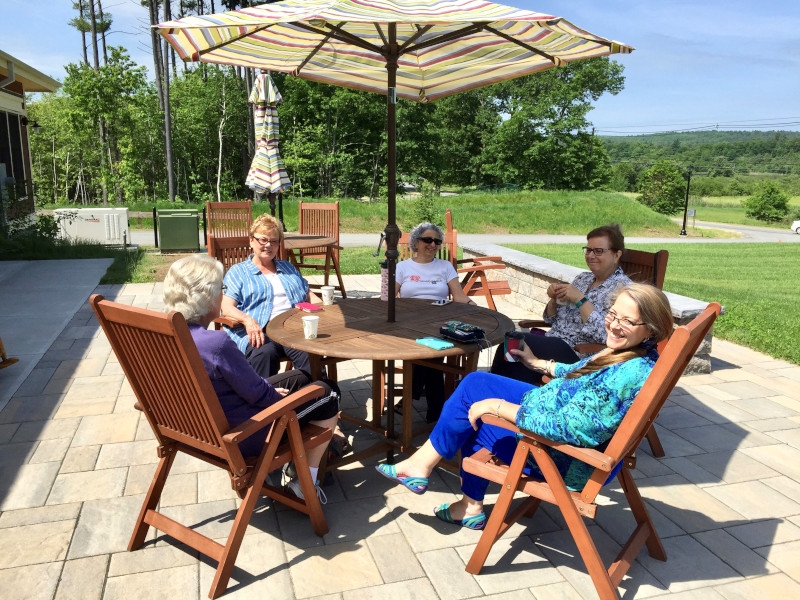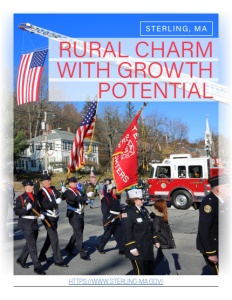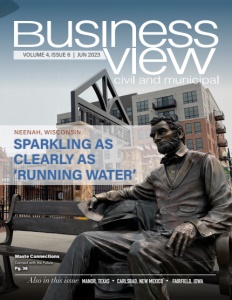Sterling, Massachusetts
rural charm with growth potential
With a picturesque backdrop, Sterling, MA is destined for economic development and growth
Nestled between Route Two and the Massachusetts Pike, with the vital artery of Interstate 190 coursing through its center, you’ll find the historic town of Sterling, Massachusetts.
A vibrant patchwork of verdant farmlands and colonial charm, it sits at the heart of New England, an emblematic specimen of America’s storied past, the bucolic tranquility of its present, and the promising potential of its future.
Sterling’s captivating allure, however, isn’t solely credited to its strategic location or vibrant community. Its appeal is deeply entrenched in its rural charm and the age-old architecture that graces its townscape.
Adding to the lure of this traditional New England village center is the expansive open space that swathes the town. Stephen Wallace, the town planner, paints a vivid picture of Sterling as a rural community north of Worcester County, where “40% of the land is permanently protected.”
Sterling’s considerable appeal lies in its commitment to preservation and its embrace of progress. The town hosts several areas zoned for industry, attesting to its balanced approach to community development. Wallace’s description of the city—a blend of “trails, open space, farmland,” and industrially zoned areas—captures the essence of Sterling’s unique juxtaposition of the old and new.
Sterling, while soaked in historical charm and brimming with natural beauty, might seem a world away from the bustling metropolises of Massachusetts. But the town is far from isolated. As Wallace indicates, “There is an MBTA commuter rail just north of us in Leominster.” The road to Boston and beyond is not far for daily commuters or those yearning for a city break.
This accessibility is paired with the promise of progress. Sterling is ready to adapt as the world moves towards remote working. Caldwell shares that Sterling is fortunate to have a municipal light department that controls its telecommunications infrastructure. They are currently building the Local Area Municipal Broadband (LAMB). So, there is a broadband network being built in town.”
Local funding initiatives support this move towards better connectivity. Caldwell mentions that the project has been allocated a portion of the town’s ARPA funds and received additional grant funding. The city also hopes for a USDA grant to expand coverage “to a pretty big percentage of the town without having to take on any debt.”
Sterling’s tranquil, rural allure does not shield it from the pressing demands of urban development, particularly in the housing sector. Wallace reports, “We’re building the North Gate apartment complex right on our northern border with Leominster. And that will accommodate 216 housing units.” This multi-family project promises to address part of the housing shortage gripping towns and cities across the US.
However, the town’s growth strategy goes beyond large-scale residential developments. In addition to new apartments, Sterling is exploring ways to cater to its senior residents. Wallace mentions, “We’re currently reviewing our town-owned properties to see if there’s any that would be suitable for affordable senior housing.” Simultaneously, he is also working with the Regional Planning Commission to identify land suitable for constructing 156 multi-family units, as mandated by new state law.
Beyond residential development, Sterling is keen on fostering a vibrant commercial scene. Wallace highlights the recent addition of Emma’s Cafe to the town’s beautiful village center and shares that a deli/food service business is considering moving into a building next to the municipal center.

The town offers a consultation service as an enticing feature for prospective businesses. “They can meet with the building commissioner and me, and we walk them through the local permitting process,” Wallace explains. For more complex projects, they even offer meetings with department heads to smooth out technical issues before permit applications.
Yet Sterling is not just welcoming new businesses; it’s also supporting revitalization efforts. The old Sterling Inn, which has been closed for a few years, is under consideration for renovation. But Sterling also recognizes the need for its growth. Wallace admits that the town’s “zoning bylaws’ options for commercial and industrial development are a bit antiquated and limited” and shares that plans are underway to revisit and modernize these regulations soon.
Balancing the preservation of Sterling’s historical charm with its growth and development is a task that the town takes seriously. Caldwell discusses the importance of workforce development. “We are doing a couple of projects with our local vocational school,” he shares, illustrating the town’s proactive approach to grooming local talent. He further admits that the challenge of “retraining and training folks to take on different roles and evolving roles” is not unique to Sterling but is a national issue.
But the town’s evolution isn’t just about economics or workforce—it’s also about preserving its historical identity. Maureen Cranson, a long-time town resident and chair of the town’s select board, reflects on Sterling’s master plan. “We have just finished our master plan. As of last year, it had laid dormant on a shelf for about 52 years.”
Cranson also reflects on the transformation of Sterling over the years. From her arrival in 1972, when the town housed roughly 3,500 residents, she’s seen substantial growth. “In ten years, just in my area alone, I saw 110 new homes being built,” she observes.
Despite this expansion, Sterling remains committed to preserving its historical landmarks. Cranson mentions Sterling Inn, a once-thriving hub that fell into disrepair. Now, the town is working with innovative minds to renovate the inn, though not necessarily to its original state. She acknowledges that sometimes change is necessary, adding that the renovated inn will likely have an “entirely different look.”
Cranson also highlights how the town center’s business landscape has evolved. Sterling has lost some of its smaller businesses to larger chain stores within a short driving distance. Yet, despite these changes, Sterling’s central location remains advantageous. “You can get anywhere to a grocery store, to a drugstore, all within ten minutes,” she asserts.
Sterling’s town center may have morphed over time, but its heart remains unchanged. A quick drive reveals everything from quaint pubs to upscale dining and family-run farms. However, as Cranson candidly admits, the town faces a significant challenge: a scarcity of employees. “You look in every shop around here, and they have help wanted signs,” she notes, reflecting a broader trend that has left many businesses understaffed and struggling.
Despite these challenges, the spirit of entrepreneurship perseveres in Sterling, with new businesses like Emma’s Cafe setting up shop amidst the uncertainty. As Cranson shares, one of the crucial goals of the town’s master plan is to move forward without losing Sterling’s rural charm. This delicate balance is no easy feat, especially when navigating the generational changes in the town’s demographic.
Eight years ago, Sterling predicted that the senior population would outnumber the student population by 2023. This prediction has come to pass, significantly shaping the town’s housing needs. “You can’t bring in new families if you can’t find housing for the seniors,” Cranson explains, highlighting a key issue: while many seniors are looking to downsize, the current market doesn’t provide many options.

Wallace also highlights this issue: “Seniors wanting to downsize their homes.” This situation has spurred the town’s search for suitable land to create affordable housing for seniors, a proactive measure to tackle the housing conundrum.
Sterling is also not a stranger to the push towards sustainability, with initiatives in place that speak to its commitment to a green future. Cranson mentions, “We have our municipal light department that has taken on the fiber end of these things,” ensuring that the town is well-placed to tackle the sustainability challenge.
When it comes to ‘walkability,’ a popular term in town planning discussions, Sterling has its unique offering. “Through the center, it’s easily walkable,” Cranson shares. She concedes the lack of sidewalks in most areas due to the town’s rural nature but compensates for this with the plethora of trails. These trails, a mix of those managed by a local land trust and the town’s conservation commission, offer residents an expansive network for strolls or vigorous hikes.
Wallace further elaborates on this topic: “We do participate in the state’s Complete Streets program.” This program aims to create a more inclusive and safe transport environment by incorporating multimodal transportation features such as sidewalks and bike lanes during road upgrades.
Further boosting Sterling’s walkability and connectivity, Wallace shares, is the work of the town’s active Open Space Committee. They plan to extend Sterling’s portion of the Wachusett rail trail, connecting it with nearby towns. This project, managed in collaboration with the Wachusett Greenways group, epitomizes Sterling’s commitment to enhancing its residents’ quality of life while respecting and preserving its rural charm.
Education in Sterling is a notable asset, contributing significantly to the town’s appeal. “We are part of a 5-town regional school district, and I believe it’s the largest regional school in the state,” remarks Caldwell.
Given its size, the district offers a range of programs that other smaller districts might not, thereby giving Sterling students an advantage. Caldwell affirms that the district performs well academically, maintaining a high standard in line with the reputation of Massachusetts for its world-class education.
The school district’s broad curriculum is noteworthy, with STEM (Science, Technology, Engineering, and Mathematics) programs incorporated from elementary to high school. Although the regional nature of the school district limits the town’s direct influence on the curriculum, it’s clear that preparing students with the skills required for the future is a priority.
In addition to formal education, Sterling also boasts programs for community engagement and developing young citizens. The Yahoo group, as Cranson mentions, consists of local students who help with town cleanups, fostering a sense of ownership and responsibility.
There’s a lot on Sterling’s plate, from updating bylaws to stimulate business growth, to initiating $7 million worth of infrastructure work and constructing a new trail by the senior center. However, these projects are not just about development but preserving the town’s history and character.
Sterling, it seems, is poised to offer an attractive alternative for those priced out of the traditional suburbs. “We’re looking much better for 20 or 30 minutes more driving,” Caldwell concludes. This sentiment echoes the underlying ethos of Sterling—a harmonious blend of historic charm, natural beauty, and modern development, all within a comfortable commute. A sterling choice indeed.
AT A GLANCE
Sterling, Massachusetts
What: Historical city with planned economic development projects to meet expected growth
Where: Located in Worcester County, Massachusetts
Website: https://www.sterling-ma.gov/



